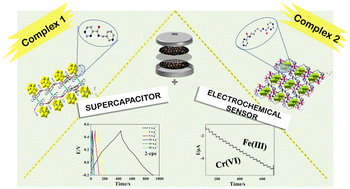Polyoxometalate-based metal–organic supramolecular architectures derived from two new pyrimidine-amide ligands as supercapacitors and multifunctional electrochemical sensors†
Abstract
Two new polyoxometalate (POM)-based metal–organic supramolecular architectures, [Cu(Hpypa)2(PMo12O40)(μ2-Cl)] 3H2O (1) and [Co(H2bpap)(γ-Mo8O28)0.5(H2O)2] H2O (2), were successfully synthesized by using two self-designed pyrimidine-amide organic ligands [N-(pyridin-3-ylmethyl)pyrimidine-4-carboxamide (pypa) and N,N′-bis(4-pyrimidinecarboxamido)-1,5-pentane (bpap)], as well as Keggin-type POM anions and octamolybdate anions under hydrothermal conditions. Complex 1 is a 1D supramolecular structure containing dinuclear [Cu2(Hpypa)4(PMo12O40)2(μ2-Cl)2] units. Complex 2 exhibits a 3D supramolecular framework consisting of 1D [Co(H2bpap)(H2O)2]n4n+ metal–organic chains and free [Mo8O28]8− anions. The supercapacitor performances of complexes 1 and 2 in a three-electrode system were investigated. When the current density is 1 A g−1, 1 and 2 exhibit specific capacitances of 555 and 675 F g−1, respectively. The symmetrical supercapacitor assembled with complex 2 as the electrode modifier exhibits an energy density of 13.4 W h kg−1 with a power density of 450 W kg−1. Capacitance retention remains at 96% after 6500 cycles. At the same time, the electrochemical sensors prepared with complexes 1 and 2 can be used for the determination of Cr(VI)/Fe(III) ions in aqueous solution with high sensitivity and low detection limit.



 Please wait while we load your content...
Please wait while we load your content...